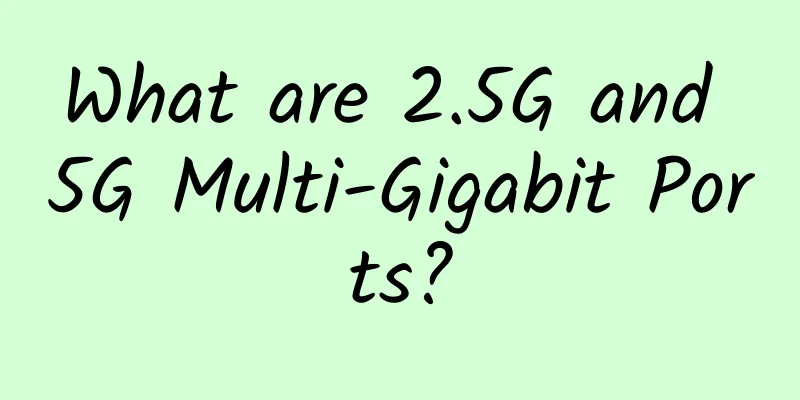What are 2.5G and 5G Multi-Gigabit Ports?

|
As technology continues to advance, Ethernet ports have evolved to offer faster speeds and higher performance. Two notable advancements in this area are 2.5 Gigabit Ethernet (2.5G) and 5 Gigabit Ethernet (5G) Gigabit ports. In this article, we’ll take a deep dive into these technologies, explore their capabilities, and provide insights to help make an informed choice between 5G, 2.5G, or 1 Gigabit Ethernet (1G). What is 2.5G and 2.5G port?2.5G is a medium Ethernet speed that provides higher bandwidth than traditional 1G, but not as fast as 10G. It provides a significant performance boost for devices that require more bandwidth, such as high-definition video streaming, online gaming and data-intensive applications. 2.5G Multi-Gigabit ports are network ports that support 2.5G Ethernet rates. 2.5G ports can be found in a variety of network devices, such as 2.5G switches, routers, and network interface cards (NICs). They are backward compatible, meaning they can also operate at slower speeds such as 1G or 1000mbps, allowing for seamless integration with existing infrastructure. What are 5 Gigabit Ethernet and 5G ports?5G is a step up in speed and provides higher bandwidth than 2.5G. It offers significant performance improvements over 1G, making it ideal for applications that require higher throughput, such as virtual reality (VR), augmented reality (AR), and high-resolution video streaming. Similar to 2.5G, 5G multi-gigabit ports are network ports designed to support 5G Ethernet speeds. 5G ports can also operate at lower speeds such as 2.5G or 1G to ensure compatibility with legacy devices and networks. 1G, 2.5G, and 5G FeaturesTo better understand the differences between these Ethernet speeds, let’s compare their key features: Bandwidth: 1G Ethernet provides a maximum bandwidth of 1,000Mbps, while 2.5G provides 2,500Mbps and 5G provides 5,000Mbps. Therefore, 2.5G and 5G provide higher bandwidth capacity, enabling faster data transfer rates. Compatibility: 1G Ethernet is widely supported by most devices and network infrastructure. 2.5G and 5G Ethernet are newer technologies and may require specific hardware support. However, both 2.5G and 5G are backward compatible. For example, a 2.5G switch can enable connectivity with 1G devices. Cost: As with any technological advancement, higher speeds generally come at a higher cost. 1G Ethernet is generally more affordable due to its widespread adoption and mature technology. 2.5G and 5G equipment may cost more, but are expected to decrease over time as the technology becomes more popular. Should we use 5G, 2.5G or 1G?Choosing the right Ethernet speed depends on your specific requirements and the devices you plan to connect. Here are some considerations. Internet Service Provider (ISP)Determine the maximum speed your ISP offers. If it's less than 1G, a 1G Ethernet connection may be sufficient. However, if your ISP offers speeds higher than 1G, upgrading to 2.5G or 5G Ethernet may be beneficial to take full advantage of the available bandwidth. Equipment CapabilitiesConsider the capabilities of the devices you plan to connect. If you have devices that require high bandwidth, such as gaming consoles, 4K streaming devices, or NAS (network-attached storage) systems, upgrading to 2.5G or 5G Ethernet can significantly improve their performance. Future-proofIf you anticipate an increase in demand on your network or plan to adopt new technologies that rely on high-speed connections, investing in 2.5G ports or 5G ports can provide future-proofing. These technologies are designed to handle higher bandwidth requirements, ensuring that your network remains relevant and efficient in the long run. BudgetConsider budget constraints. While 2.5G and 5G Ethernet offer superior performance, they can cost more compared to 1G Ethernet. Evaluate your budget and weigh the trade-offs against your specific needs to make an informed decision. Network InfrastructureEvaluate your existing network infrastructure and determine its compatibility with higher Ethernet speeds. Upgrading to 2.5G or 5G Ethernet may require compatible 2.5G/5G switches, routers, and network cards. Before making the switch, make sure your network equipment supports the desired Ethernet speed. in conclusionIn summary, compared with traditional 1G Ethernet, 2.5G ports and 5G ports provide higher bandwidth and higher performance. They meet the growing needs of modern applications and devices that require faster data transmission rates. Evaluating specific requirements, equipment capabilities, budget, and network infrastructure will help determine whether to choose 5G, 2.5G, or 1G Ethernet. Keep in mind that the choice should meet current and future network needs to maximize the benefits of these advanced Ethernet technologies. |
<<: 5G industry applications need to be expanded from "1 to N"
>>: What exactly is “5G New Call”?
Recommend
[Hard-core literacy] What exactly is coherent optical communication?
introduction: Hello everyone, I am Xiaozaojun. In...
Architecture Design: Sidecar Pattern Explained
Context and Questions Modern applications usually...
BandwagonHost: CN2 GIA special price replenishment starting from $83.8/year, 2GB/40G SSD/[email protected]/multiple nodes optional
[Updated on February 27, 2024] Bandwagonhost has ...
Friendhosting Spring Promotion, VPS at least 45% off for half a year starting from 7.6 euros
Friendhosting is a Bulgarian hosting company esta...
V5.NET: 20% off Hong Kong international servers, E3-1230/8GB/240G SSD/15M monthly payment starts from 340 yuan
V5.NET has launched a new promotion, currently of...
A brief analysis of traffic management of Istio component Envoy
Background The development convenience brought by...
In-depth analysis of SDN switch configuration and application issues
SDN (Software Defined Networking) is an emerging ...
25 years later, the CDMA legend ends
On June 12, South Korea's Ministry of Science...
RackNerd: $9.49/year KVM-768MB/12GB/2TB/San Jose and other data centers
RackNerd released a March promotion plan, includi...
The three major operators are accelerating their computing power
Computing power is the core of cloud computing. W...
How should spaces and plus signs in URLs be encoded?
[[427910]] This article is reprinted from the WeC...
With the rise of new infrastructure and other demands, the upgrade of the next generation domain name system is imminent
When it comes to the Internet domain name service...
Survey: U.S. users are dissatisfied with internet service providers, with satisfaction ranking near the bottom
On June 8, a research organization recently relea...
How to balance the development of Wi-Fi 7 and future 5G/6G?
As society progresses, people's demand for in...
16 real-life digital transformation success stories
【51CTO.com Quick Translation】CIOs of leading comp...









